https://cornerstone.lib.mnsu.edu/cgi/viewcontent.cgi?article=1156&context=all
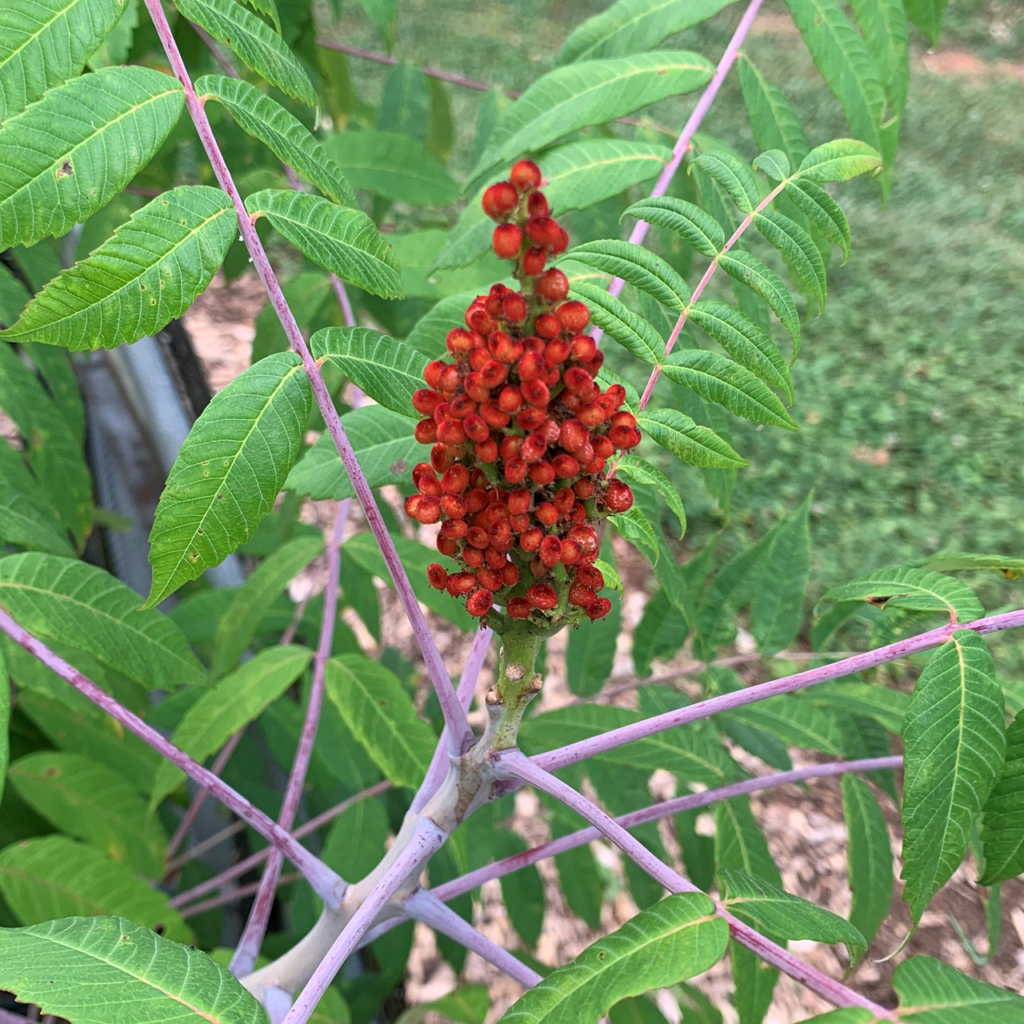
Smooth Sumac (Rhus glabra )
Image Credit: The Monticello Shop
Height: 8 – 12′
“Smooth Sumac, a native of Eastern North America from Quebec to Georgia, has been in cultivation since the early 17th century. Thomas Jefferson included this species in a list of native plants and seeds he requested from Philadelphia nurseryman John Bartram, Jr., to be sent to him in Paris in 1786. This sumac forms large colonies and is best planted in wilder areas or to stabilize embankments. The flowers are attractive to butterflies and birds feast on the persistent berries in winter. ” The Monticello Shop
“Smooth Sumac (Rhus glabra ) “bakwaˈ nak” [binding tree]. According to Jack Doud and other Flambeau Ojibwe all parts of the Smooth Sumac are suitable for medicine, the root bark, trunk bark, twig bark, leaves, flowers and fruit. The root bark tea is used as a hemostatic. Trunk and twig innerbark are used in combination with other medicine for their astringent qualities. Blossoms are sometimes steeped for sore eyes, leaves are used in poultices, and the fruit is considered a throat cleanser as well as being the basis of a beverage. Eclectic practitioners, or the old time herbalists, used the berries of Rhus glabra because of the malic acid in the skin, claiming it to be a good gargle in acute throat inflammation.” Smith, Native American Medicine
“Smooth Sumac (Rhus glabra L.), “bakwaˈ nak” [binding tree]. The Flambeau Ojibwe gather the berries to make a pleasant beverage much like lemonade. The berries are tart and are sweetened with maple sugar, soaked in water until required for use. They also gather and dry them for winter use. The dried berries are cooked in water with maple sugar, and form a hot drink, instead of a cooling one, as used in the summer and fall.” Smith Native American Food
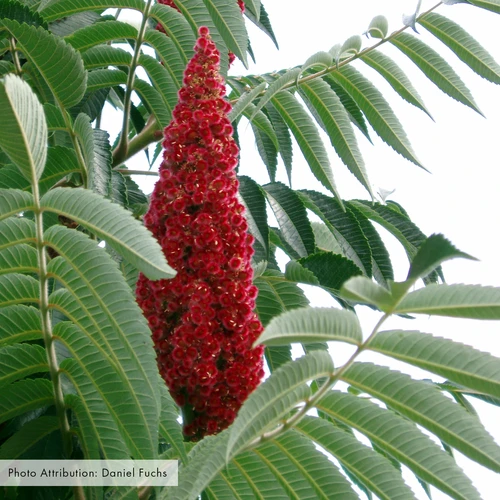
Staghorn Sumac (Rhus typhina )
Image Credit: Missouri Department of Conservation
Height: 15 -25′
“The wild Staghorn Sumac, native throughout eastern North America, was an early introduction to Europe and was familiar to English herbalist and botanist John Parkinson who called it the “Buckes Horn tree of Virginia” in 1629. The new branches are covered in fine, velvety, reddish-brown hairs similar to the growing antlers of a stag, hence the common name. Native American tribes and settlers found many uses for this plant: the leaves were smoked with tobacco and used to tan leather, and the fruits were steeped in a cooling drink similar in taste to lemonade. ” The Monticello Shop
“Staghorn Sumac (Rhus typhina.) “bakwanaˈ tîg” [binding tree].[93] The Staghorn Sumac was absent from the Flambeau Ojibwe territory, but plentiful around Leech Lake, Minnesota, while the Smooth Sumac was not found near Leech Lake. The Pillager Ojibwe only used the root as a medicine to stop a hemorrhage. They suggested that they had heard of it being used in medicinal combinations but did not know how to make or use them.” Smith, Native American Medicine
“Staghorn Sumac (Rhus typhina L.), “bakwaˈ natîg” [binding tree].[131] The Pillager Ojibwe use the berries in the same way as the Flambeau Ojibwe use this species, and under the same name. They also store up the dried seed heads for winter use.” Smith Native American Food
“OJIBWE DYE PLANTS ANACARDIACEAE (SUMAC FAMILY) Smooth Sumac (Rhus glabra L.), “bakwaˈnak” [binding tree]. The Flambeau Ojibwe use the inner bark and the central pith of the stem of the Smooth Sumac, mixed with Bloodroot to obtain an orange color. The material is boiled in the mixture. Staghorn Sumac (Rhus typhina L.), “bakwanaˈtîg”. The Pillager Ojibwe do not have the Smooth Sumac, but use the Staghorn Sumac in the same way as the Flambeau Ojibwe use the other. The writer was unable to discover how they set the color unless it was with some stone dust that accumulated in the base of the kettle.
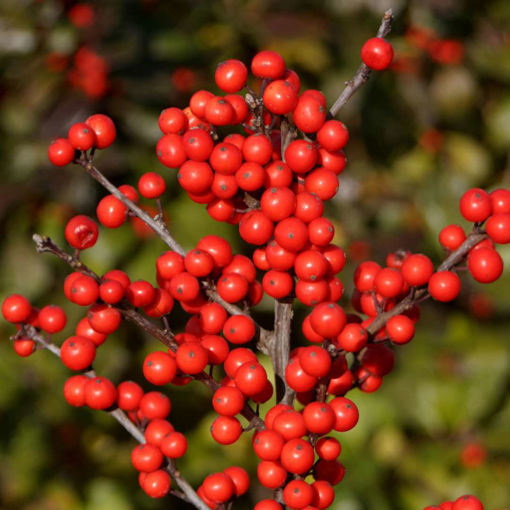
Berry Heavy Winterberry – Image Credit: Arbor Day
Height: 6′ – 8′
I have ordered 2 of these to plant this spring.
“Winterberry (Ilex verticillata [L.] Gray), “aweˈnîsibûg” [wintergreen leaf], and “anîmûˈcîmînûn” [dog berry]. The bark of this native holly is medicine among the Flambeau Ojibwe, but the use could not be discovered, other than that it might be used for diarrhea. Winterberry has been employed by eclectic practitioners as a tonic and astringent. It has been substituted for quinine in the treatment of periodical fevers, and also used in the treatment of diarrhea. The eclectic practitioner has also used it in treating malignant ulcers and chronic skin eruptions.” Smith, Native American Medicine
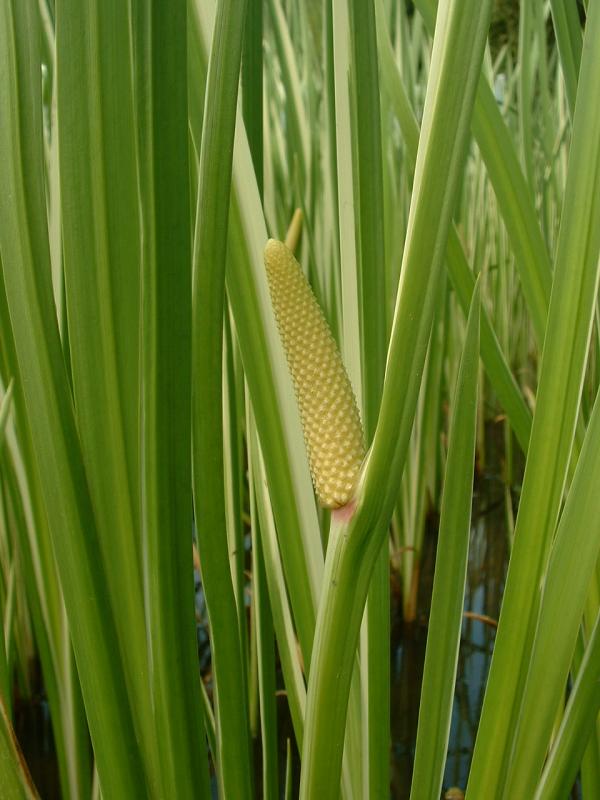
Sweet Flag – Image Credit: Wikipedia
Height: 24′ – 30″
“Sweet Flag (Acorus calamus L.) “naˈ bûgûck” [something flat]. The root of Sweet Flag is a quick acting physic, supposed to act in half a day. Bearskin cautioned the writer that no more than one and a half inches was to be used, as more would make one ill, and even this much is quite harsh. The Pillager Ojibwe recognize the Sweet Flag under the name “weˈke”, which is the same word used by another tribe for the Yellow Water-lily, and by another for the Blue Flag. John Peper said that the root was used for curing a cold in the throat or for curing a cramp in the stomach. In earlier days, among the whites, slices were candied to create a more popular form of medication. It was formerly used among the white men as a tonic for dyspepsia and for correcting flatulent colic. It was also supposed to be beneficial as a mild stimulant in typhoid cases.” Smith Native American Medicine
“Ginseng (Panax quinquefolium L.) “jîssêˈns.” Evidently the word they used was an attempt to pronounce the white man’s term for it. The writer was unable to discover any medical use made of it by the Ojibwe, though they gathered it assiduously for sale to the traders. Their method of gathering was a thoughtful one. Although they undoubtedly recognized it in any stage of growth, they only gathered the root when the red berries were mature, but before they were ready to drop. Into the hole from whence the root came, they would thrust the whole fruiting top, and carefully firm the soil upon it. Knowing the location well, they would revisit the place in three to five years and find more roots than they harvested in the first instance. According to our pharmacopoeia, the medicinal value of ginseng is almost nothing, but there is a great market for it in China, where it is worshipped as a sort of fetish, and is acclaimed as a panacea for sexual impotency, nervousness, vomiting and dyspepsia. The more nearly the root approximates the human torso, the more valuable it is to the Chinese. Thus one root in a six hundred-pound bale may be worth many times the entire remainder of the bale, and when ten dollars a pound is the price, one can realize the extreme value of such a piece.” Smith Native American Medicine
“Wild Ginger (Asarum canadense L. var. acuminatum Ashe.) “nameˈ pîn” [sturgeon potato].[96] The Pillager Ojibwe called this a potato for sick people. They are supposed to chew the root, and then they can eat anything they desire. The white man calls this Canada Snakeroot in his dispensatories, considering it a feeble remedy with tonic, aromatic and diuretic properties. Cases of convalescent acute febrile infections are sometimes given the extract of wild ginger root.” Smith Native American Medicine
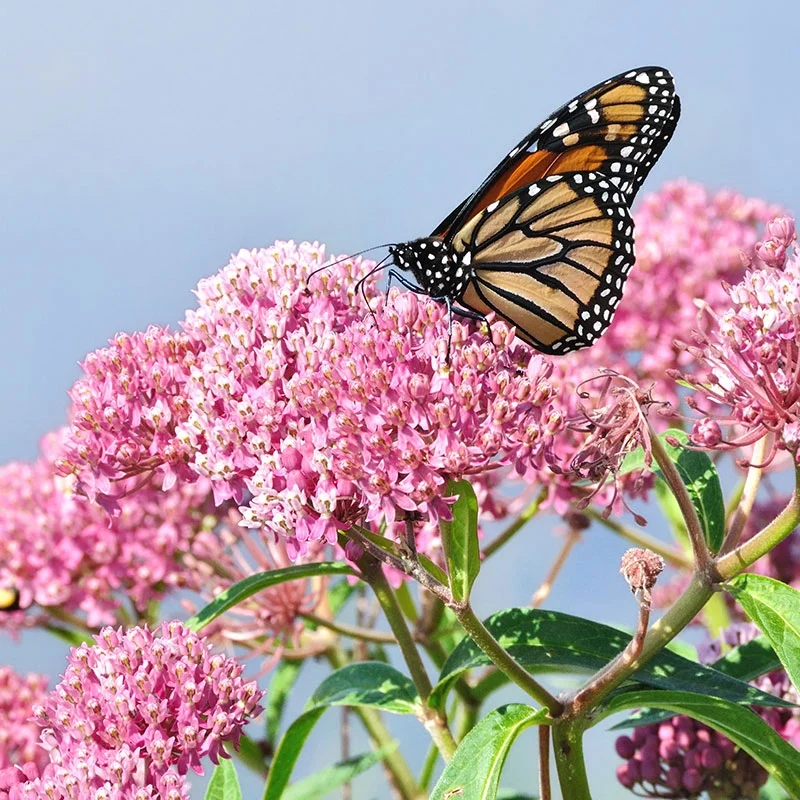
Milkweed ‘Soulmate’ Swamp Asclepias incarnata) – 3 plants
Image Credit: American Meadows
Height: 24-36″ tall
“Common Milkweed (Asclepias syriaca L.) “caboˈ sîkûn” [milk] or “înîniˈwûnj” [Indian plant], according to Flambeau Ojibwe.[97] Although the Pillager Ojibwe used this chiefly for food, the root was also used as a female remedy, but for what phase of illness, we were not able to discover. Eclectic practitioners have used the roots as counter-irritants or internally as stomachics, carminatives, or anti-spasmodics of the stimulating class.” Smith Native American Medicine
“Common Milkweed (Asclepias syriaca L.), “caboˈ sîkûn” [milk], “înîniwûnj” [indian plant] Flambeau name.[133] The Pillager Ojibwe eat the fresh flowers and tips of the shoots in soups. They are usually cooked with some kind of meat and become somewhat mucilaginous like okra, when cooked. They also gather and dry the flowers for refreshening in the winter time, to make into soup.” Smith Native American Food
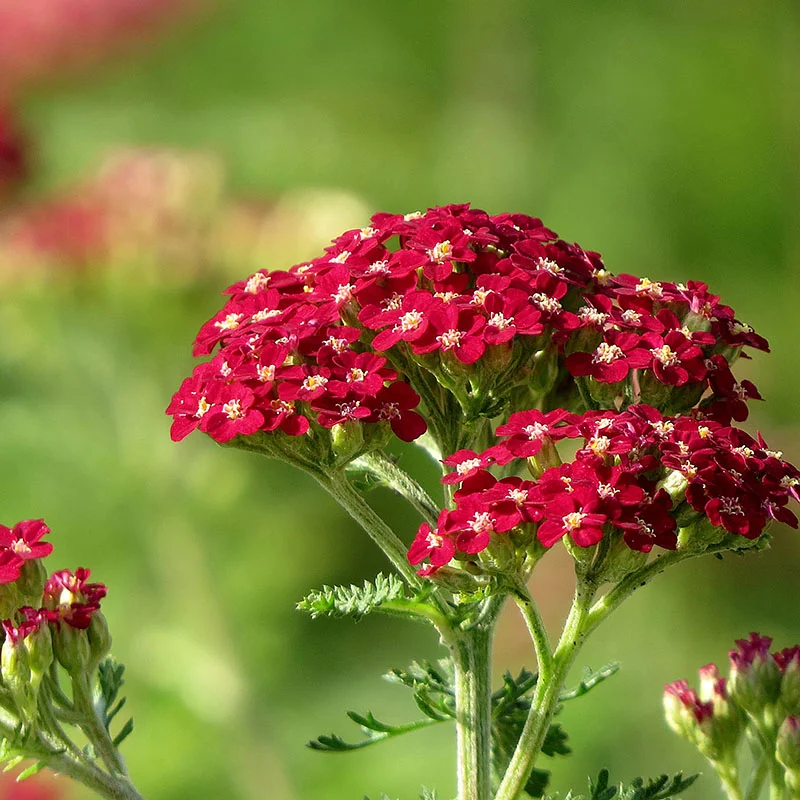
Yarrow ‘Vintage Red’ (Achillea millefolium)
Image Credit: American Meadows
Height: 12-24″ tall
‘Common Yarrow, which was used for its bitter and aromatic principles. It was used as an emmenagogue and for various ailments of the reproductive organs. It was sometimes used to cure diseased conditions of the entire gastro-intestinal tract. Yarrow (Achillea millefolium L.), “adjidamoˈ anûk” [squirrel tail].[102] The Pillager Ojibwe used the florets in ceremonial smoking and placed them on a bed of coals inhaling the smoke to break a fever. Yarrow has always been a home remedy of the white man, and the Germans still use the dried flowers in a tea, called “schafesgarbetee”, to break a fever.” Smith Native American Medicine
White Sage (Artemisia ludoviciana Nutt.) “îmbjîˈgoa” according to White Cloud, Bear Island Ojibwe, but “wîngûskw” or “bebejiˈgogaˈnji” [horse medicine] by John Peper, another Bear Islander. Peper said the Pillager Ojibwe used it as a horse medicine, but the Sioux smoked it. Miners and frontiersmen prized it in their treatment of “mountain fevers.” Smith Native American Medicine
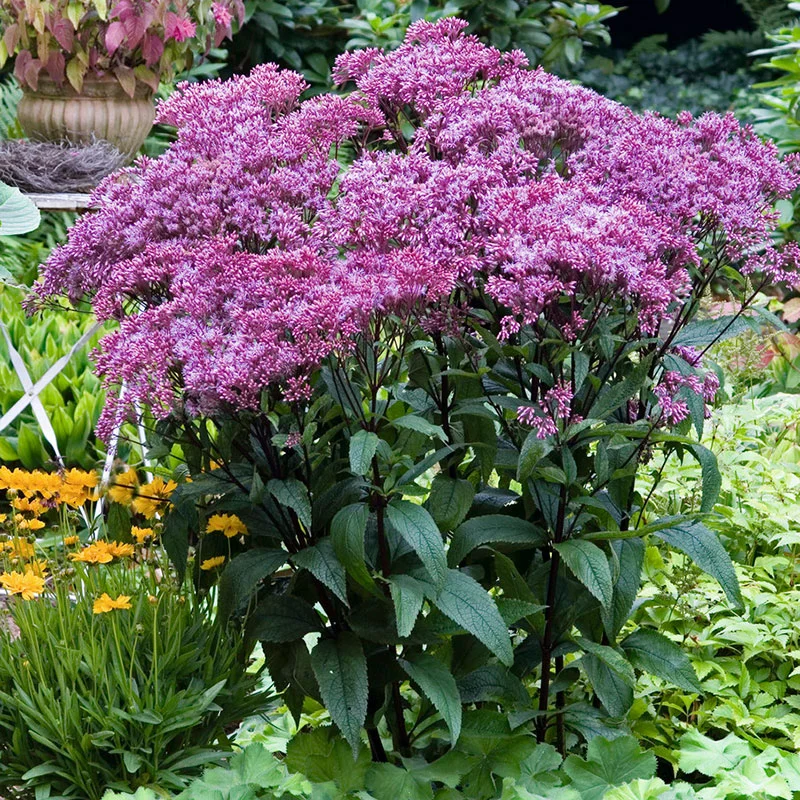
Joe Pye Weed ‘Baby Joe’ (Eupatorium dubium)
Height: 24-36″ tall
“Joe-Pye Weed (Eupatorium purpureum L.), “bûˈ gîsowe” [bathing]. The Flambeau Ojibwe make a strong solution of the root, with which to wash a papoose up till the time he is six years old. This is supposed to strengthen him.” Smith Native American Medicine
“Black-eyed Susan (Rudbeckia hirta L.). The Flambeau Ojibwe claim that this plant is adventive from the south and have no name or use for it. It has been used by the white men as a diuretic.”Smith Native American Medicine
“Fragrant Golden-rod (Solidago graminifolia [L.] Salisb.), “wasaˈ waskwûneˈk” [yellow light]. Besides being of use in hunting medicine, the flowers in infusion were used by the Flambeau Ojibwe for a pain in the chest. Golden-rod leaves and flowers have at times held a rather important place in materia medica, for their carminative, and antispasmodic properties. They have also been used as an intestinal astringent.” Smith Native American Medicine

Wild Geranium Geranium maculatum)
Image Credit: The Monticello Shop
Height: 18 – 24″
“In his New England Rarities (1672), John Josselyn called the Wild Geranium “Raven’s-Claw,” and in 1814 Frederick Pursh noted the name “Alum-root, on account of the astringent taste of the roots.” Its name derives from geranos, the Greek word for crane, alluding to the long beak of the seed. While in France in 1786, Thomas Jefferson requested plants of this species from the nursery of Quaker botanist John Bartram, Jr. to share with his many Parisian friends. Wild Geranium grows abundantly in the forests of Monticello today and is not attractive to deer.” The Monticello Shop
“Wild Geranium is our showiest native geranium, with large lavender-pink blooms. Its’ gorgeous, sculpted foliage appears early in the season and graces the garden all season long, with an attractive mounding habit that makes an ideal groundcover. This woodland wildflower blooms for several weeks early to mid-spring, supporting pollinators – especially native bees. Wild Geranium is perfect for naturalizing in shady gardens. (Geranium maculatum)” American Meadows
‘Wild Geranium (Geranium maculatum L.), “oˈ sawaskwîniˈ s” [yellow light].[107] The Pillager Ojibwe use the astringent root for the treatment of flux, and also for healing a sore mouth. Eclectic practitioners have also used it as a mild internal astringent, useful for infants and people who have a delicate stomach, because it is not irritating. It is valuable in serious diarrheas. It has also been used by white men for rectal and vaginal injections to tone up weak muscles.” Smith Native American Medicine
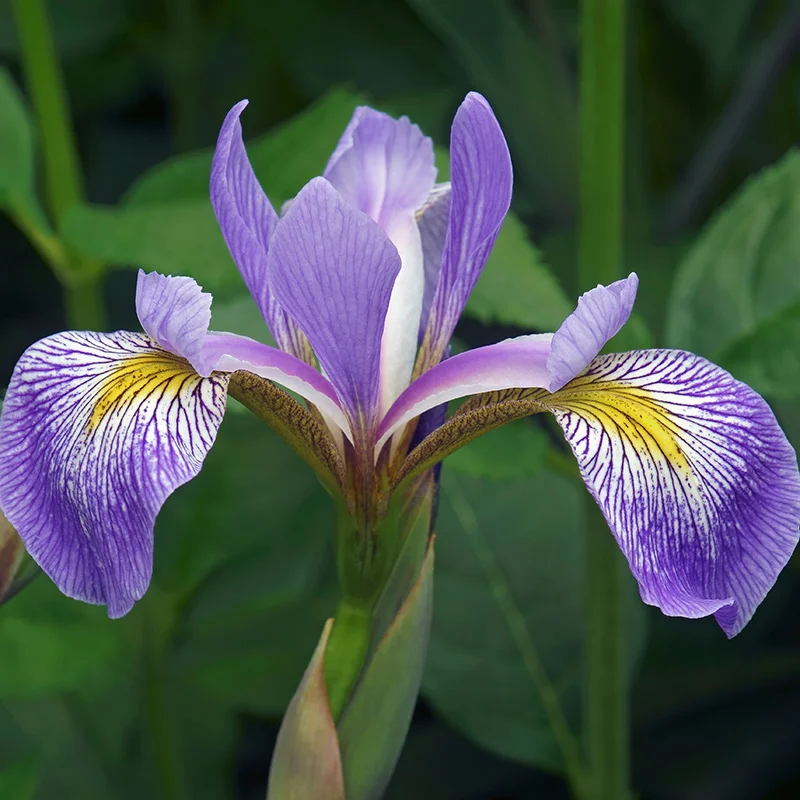
Iris Southern Blue Flag Iris – (Iris virginica var. shrevei)
Image Credit: American Meadows
Height: up to 36″ tall
“Blue Flag (Iris versicolor L.), “naˈ bûkûck”.[109] The Flambeau Ojibwe use a half inch of the root boiled in water as a quick physic. Under the name “caboˈsîkûn” [milk root], the Pillager Ojibwe use a little piece of the root in boiling water, drinking a tablespoonful and a half as an emetic and physic. Blue Flag root has been accounted one of the most valuable remedies by the eclectic practitioner. It is alterative, cathartic, sialagogue, vermifuge and diuretic. It has been used in scrofula and syphilis, chronic hepatic, renal and splenitic affections.” Smith Native American Medicine
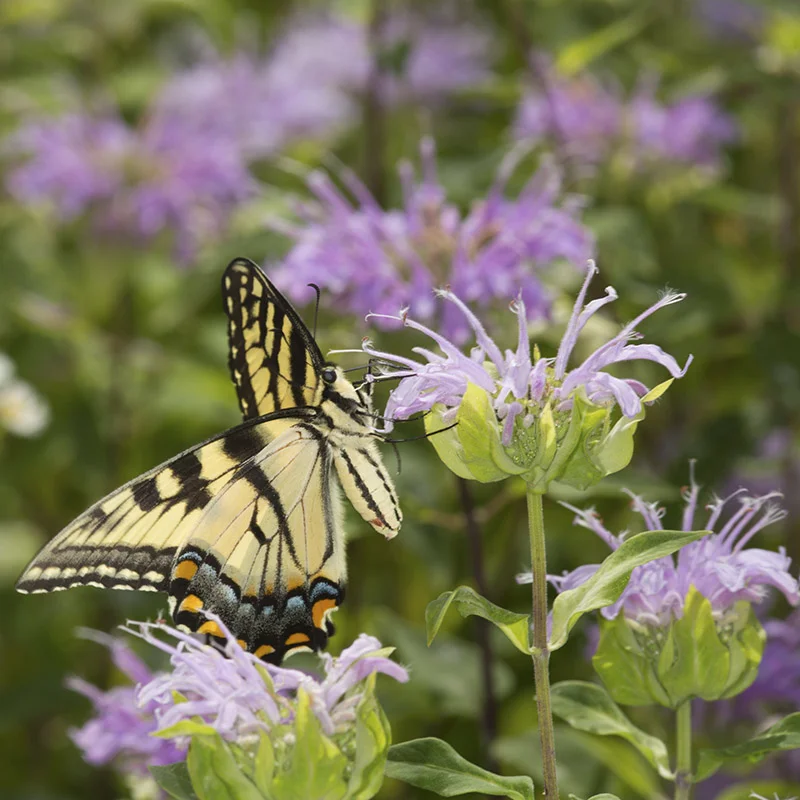
Wild Bergamot (Monarda fistulosa)
Image Credit: American Meadows
Height: 24 – 48″ tall
“Wild Bergamot (Monarda fistulosa L.), “wecaˈ wûs wackwîˈ nek” [yellow light].[111] The Flambeau Ojibwe gather and dry the whole plant, boiling it in a vessel to obtain the volatile oil to inhale to cure catarrh and bronchial affections. In some sections, the whites use it as a domestic antiperiodic and diaphoretic.” Smith Native American Medicine
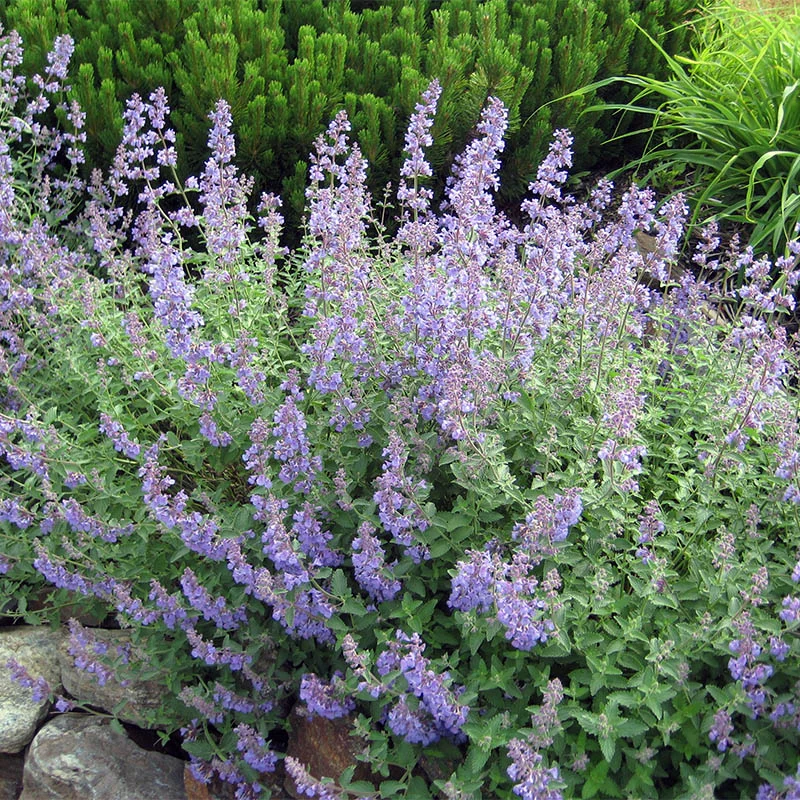
Catmint ‘Walker’s Low’ Nepeta (Nepeta faassenii)
Image Credit: American Meadows
Height: 24-30″ tall
“Catnip (Nepeta cataria L.) “tciˈ nameˈ wûck” [big sturgeon plant].[112] The Flambeau Ojibwe brew a tea of catnip leaves for a blood purifier. The mint water obtained by steeping the herb in lukewarm water is used to bathe a patient, to raise the body temperature. The plant is employed by the whites as an emmenagogue and antispasmodic. It has been used as a carminative to allay flatulent colic in infants, and is supposed to be useful in allaying hysteria.” Smith Native American Medicine
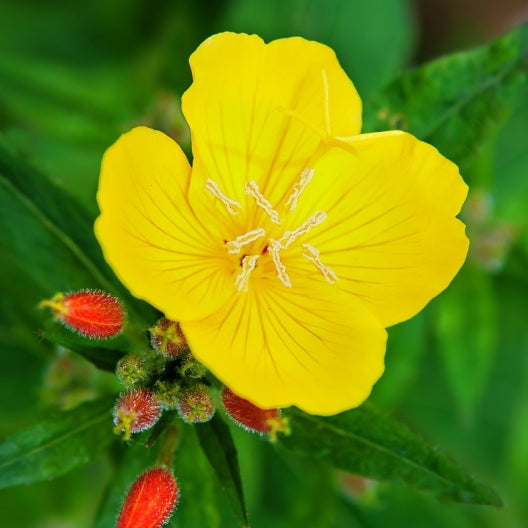
Evening Primrose
Image Credit: Eden Brothers
“Evening Primrose (Oenothera biennis L.) While the Flambeau Ojibwe have no Indian name for this, still they use the whole plant soaked in warm water to make a poultice to heal bruises. Because of its antispasmodic properties, the white man has used it internally in the treatment of whooping cough, hiccough and spasmodic asthma” Smith Native American Medicine
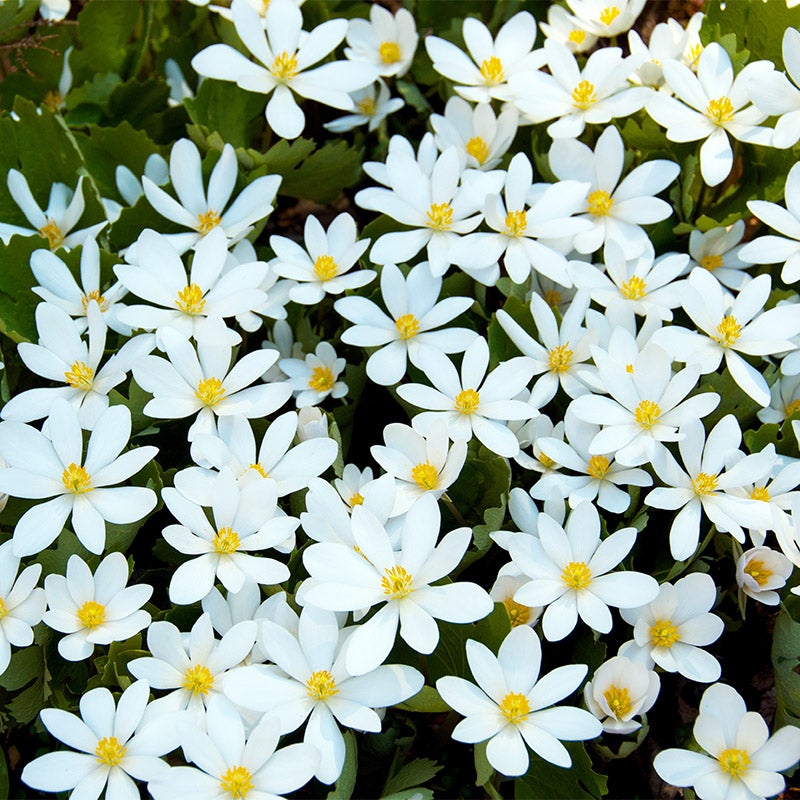
Bloodroot (Sanguinaria canadensis)
Image Credit: American Meadows
Height: 6-8″ tall
“Bloodroot (Sanguinaria canadensis L.)[116] “meskwaˈ djiˈ bîkûk” [red root]. The Pillager Ojibwe use the orange-red juice of the Bloodroot to cure sore throat. The juice is squeezed out on a lump of maple sugar, and this is retained in the mouth until it has melted away. They also use the juice to paint the face for the medicine lodge ceremony or when on the warpath. Sanguinaria is official only in the U. S. Pharmacopoeia, and in small doses it produces a sense of warmth in the stomach and stimulates gastric secretion. It is given as an expectorant and in larger doses as an emetic.” Smith Native American Medicine
“Bloodroot (Sanguinaria canadensis L.), “meskwaˈdjibîkûk” [red root]. The Ojibwe use this root in four or five combinations in dyeing various materials. It is not necessary to mix it with other materials to set the color and alone it gives a dark yellow or orange color. They use it to paint the face, also, making different clan marks with it. Either the fresh root or dried root may be used.”Smith
“Common Plantain (Plantago major L.), “cecaˈ gûskiˈ bûge sînk” [leaves grow up and also lie flat on the ground].[118] The Flambeau Ojibwe soak the leaves in warm water then bind them on bruises, sprains or sores as a poultice. It is also a healing and soothing remedy for burns, scalds, bee stings, and snake bites. The Flambeau Ojibwe also refer to it as “pakwan”. The Pillager Ojibwe use it in the same manner but call it “jimûckiˈ gobûg” [sort of swamp leaf]. Although plantain is a feeble remedy, it has been ascribed potency in many diseases by eclectic practitioners. They still use it to some extent in treating inflammation of the skin, malignant ulcers, intermittent fevers, etc. The leaves are of some value in arresting hemorrhages when applied to the bleeding surfaces. The writer cured a badly swollen and lacerated hand, which swelled to three times its normal size, probably because dirt from a sewer was ground into it, with the simple leaf bound upon the hand.” Smith Native American Medicine
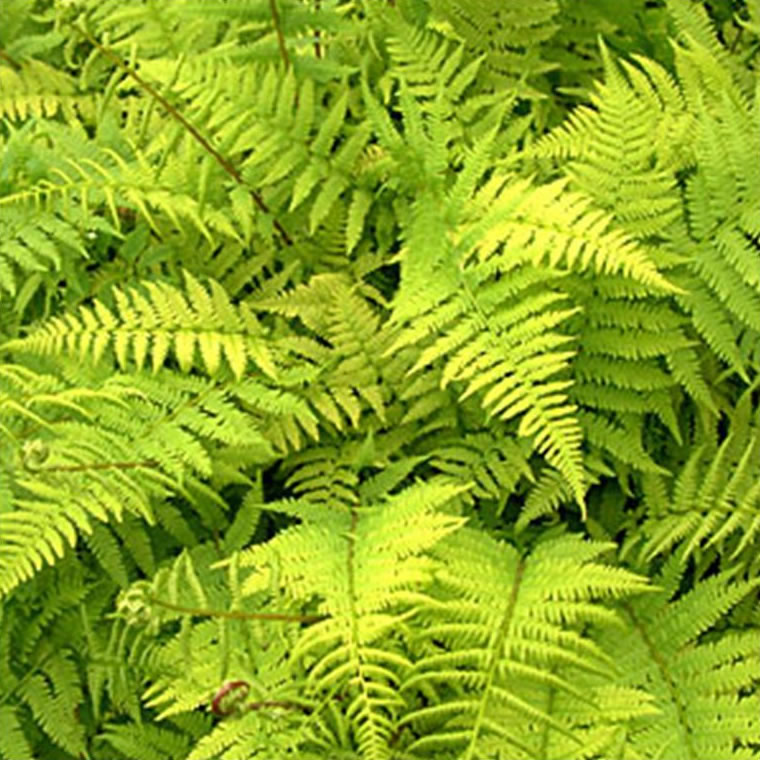
Lady Fern (Athyrium filix-femina
Image Credit: U.S. Forest Service
Height: 24-36″ tall
“Female Fern (Asplenium filix-femina [L.] Bernh.), “anaˈ ganûck” [fern]. The Flambeau Ojibwe grate the dry root into a powder which is used as a healing powder for sores. The Pillager Ojibwe call it “nokomiˈ skînûn” [grandmother?]. The root is made into a tea to cause milk flow in patients with caked breast. There is a record of its medicinal use by white men to alleviate backache.” Smith Native American Medicine
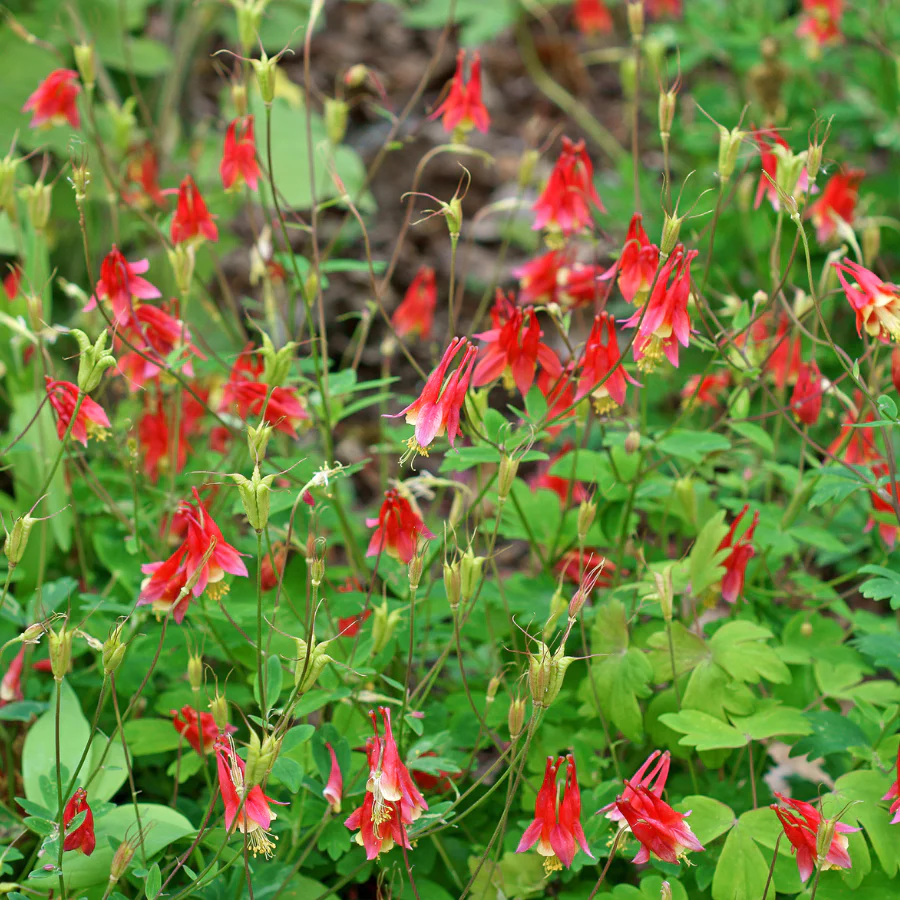
Wild Red Columbine (Aquilegia canadensis)
Image Credit: Grower’s Exchange
Height: 12-36″ tall
“Wild Columbine (Aquilegia canadensis L.), shown in plate 74, fig. 1. The Pillager Ojibwe have no name for this plant, but the root is considered a good medicine for stomach trouble. Eclectic practitioners consider it a diuretic, diaphoretic, and antiscorbutic, using it in jaundice, in smallpox to promote eruption, and in scurvy.” Smith Native American 💊
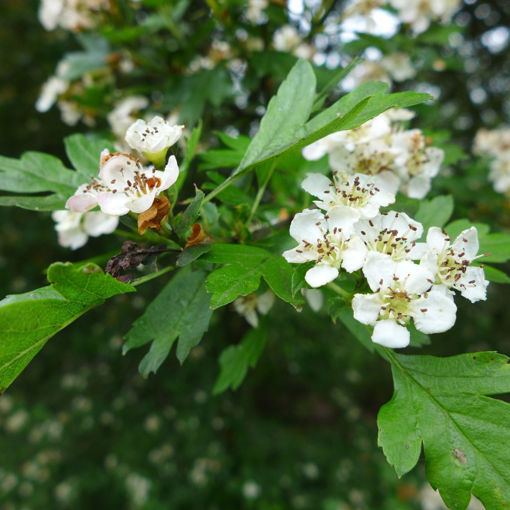
“Hawthorn (Crataegus sp.), “mînesagaˈ wûnj” [berries and thorn bush], shown in plate 77, fig. 2. The Flambeau Ojibwe use both the fruit and the bark for medicine, a kind not made now, other than for women. Eclectic practitioners have used the berries for their astringent and reputed cardiac properties.” Smith Native American Medicine
“Hawthorn (Crataegus sp.), “mîneˈsagaˈwûnj”. The Flambeau Ojibwe women use the sharp thorns for sewing awls on finer work such as buckskin sewing with sinew.” Smith

Image Credit: American Meadows
Height: 4″ tall
“Wild Strawberry (Fragaria virginiana Duchesne), “odeˈ imînîdjiˈ bîk,” [heart berry root].[120] The root of the common Wild Strawberry is used to make a tea good for the stomach-ache, and especially for babies. The white man uses the herb as an astringent and tonic for convalescents and especially for children having bowel and bladder weakness.” Smith Native American Medicine
“Wild Strawberry (Fragaria virginiana Duchesne), “odeˈ imîn” [heart berry]. Both Flambeau and Pillager Ojibwe have the same name for the Wild Strawberry, and call it the heart berry from its shape and color. They are very fond of it in season and make preserves of it for winter use.
“Wild Plum (Prunus nigra Ait.), “bûgeˈ sanatîg”. The Pillager Ojibwe find quantities of the Wild Plum in thickets and gather it for food and for preserves.”
“High Bush Blackberry (Rubus allegheniensis Porter), “oˈdatagaˈ gomîc” [its name].[124] The Flambeau Ojibwe boil the canes to obtain a tea that is used as a diuretic. The roots furnish a tea for arresting flux. Blackberry and Dewberry root are official in the U. S. Pharmacopoeia because of their tonic and astringent properties. They are favorite household remedies among white men in the treatment of summer diarrhea of children and adults. Blackberry cordial is often used for the same purpose.” Smith Native American Medicine
“Red Raspberry (Rubus idaeus L. aculeatissimus [C. A. Mey] Regel & Tiling) “meskwaˈ mînagaˈ wûnj” [red bush berry]. The Flambeau Ojibwe value the berries as a seasoner for their medicines. That is, the flavor is used to disguise less pleasant ingredients. The root bark makes a tea for healing sore eyes. Under the name Rubi Idei Fructus, N. F. white men use the berries for making an agreeable syrup as a vehicle for less pleasant tasting medicines. When the Red Raspberry is not readily available the Black Cap Raspberry is used in the same manner” Smith Native American Medicine
Wood Betony (Pedicularis canadensis L.), “mandamîˈ nîodjiˈ bîkîns” [little corn root]. According to John Peper, Pillager Ojibwe, this root was a bad kind of medicine, an aphrodisiac, when cut fine and placed in some dish of food without the knowledge of those who were going to eat it. There is no record of its medicinal use by the whites.
Mullein (Verbascum thapsus)
Image Credit: Mother Earth Living
Height: 5 – 10′
“Mullein (Verbascum thapsus L.). The Flambeau Ojibwe have no name for this since it has come into their territory from the south and they do not use it. The writer has gathered this for his grandmother who smoked the leaves for relieving asthma and bronchitis. The flowers are supposed to have diuretic properties and have been used in the treatment of tuberculosis.” Smith Native American Medicines
“Cat-tail (Typha latifolia L.), “bebamasûˈn” [it flies around]. The Flambeau Ojibwe used the fuzz of the fruit for a war medicine. They claim that the fuzz thrown into an enemy’s face will blind him.” Smith Native American Medicine
“Hop (Humulus lupulus L.), “jiwîˈcgoniˈbûg”. The Pillager Ojibwe use the common hop to make a tea which acts like saleratus on the system, increasing the excresence of urine and reducing its acidity. It is official in the U. S. pharmacopoeia as a tonic, diuretic, sedative and somewhat anaphrodisiac.” Smith Native American Medicine
“Dandelion (Taraxacum officinale Weber) “wecaˈ waskwûneˈ k” [yellow light]. The Flambeau Ojibwe gather the young leaves in the spring and cook them with pork or venison for greens, using vinegar made from soured maple sap.” Smith Native American Food
“Cucumber (Cucumis sativus L.), “eckaˈdamîn” [its name]. The Ojibwe use their cucumbers raw, but sometimes flavor them with a vinegar “cîwa ˈbo” made from souring maple sap. They are further flavored with powdered maple sugar. \
“Ojibwe Squash (Cucurbita maxima Duchesne), “ogwîˈssi maun owaso kwoneˈk” [pumpkin, yellow light]. Their word “ogwissimaun” literally means “tangled hairs”, and refers to the strings inside upon which the seeds are borne. The Flambeau Ojibwe cultivate their own variety of squash, although they say that they got it originally from the Iroquois. They dry rings of squash for winter use. |
“Large Pie Pumpkin (Cucurbita pepo L.), “missaˈ bîgon” [little giant plant]. They have cultivated this original Ojibwe dark yellow pie pumpkin since long before the advent of the white man. They cut it into rings and sun dry it for winter use.
“Gourds (Lagenaria vulgaris Ser.), “jicaˈwîgan” [hollow like]. The Ojibwe cultivate the gourds, which they eat when young, before the rind has hardened. They also make use of them for drinking and dipping cups, and for rattles in the medicine lodge. The medicine man, “mîdewag”, keeps the rhythm of his songs by shaking them. They are pierced, kernels of corn or shells inserted, and then corked again for use.” Smith Native American Food
“Cranberry (Vaccinium oxycoccos L.), “mûckiˈ mîn” [swamp berry] shown in plate 67, fig. 2. This is an important wild food of the Flambeau Indians and also of the Pillager Ojibwe, who use a slightly different pronunciation, “mûckîtciˈ mîn” [swamp berry]. The train men that go through that reservation never seem to tire of getting Johnnie Frog to say “cranberry pie” for them in Ojibwe. It sounds so complicated because they really have no word for pie in their language but must say, “swamp berries made into sauce rolled between bread”,—“mûckiˈ gimînûn backiˈ mînasîgûn wiwegidaˈsîgûn”.
“Blueberry (Vaccinium pennsylvanicum Lam.), “mînûn” [berries]. The Flambeau and the Pillager Ojibwe harvest quantities of blueberries both for themselves and to sell. They dry them in large quantities on raised scaffolds of rush mats, like currants, or raisins, which they somewhat resemble. In the winter, they like to cook them with dried sweet corn, sweetened with maple sugar. They also cook them with wild rice, and venison and make a sweet bread with them. They have different names for different varieties of blueberries. The Low Blueberry (V. vacillans Kalm.) is called “gimîneˈsît” while the low Black Blueberry (V. nigrum [Wood] Britton) is called “makateˈ mîn” [black blueberry]. No specimens of the last two were secured, but the names were common among the Ojibwe.” Smith
“Corn (Zea mays L.), “mandaˈ mîn”. Corn is a traditional heritage of the Ojibwe, although none knew a time when they did not have it. Their origin myth is that it was a pinch of flesh taken from the side of their culture hero, Winabojo, by himself and cast upon the ground, to grow and become corn for them. This is the same as acknowledging that they do not know how it came to be here. When mandamin matures, they say that only horses can eat it raw in that condition. They have to soak it in lye water, wash out the lye and then parboil it to prepare it for the table. This is the same as our hominy. Scientists think now that corn originated in Mexico from an accidental crossing of teosinte and gama grass. While the Ojibwe cultivate and grow the approved strains of corn for Wisconsin, they also cling to their own “calico” corn, with all sorts of colors of grains on different cobs. They have two names for sweet corn,—“wîckobiˈ mandaˈmîn” [sweet maize], and “wîckobiˈ sîˈganûg” [turns sweet in cooking]. Their sweet or soft corns are different from those used by the white man. They roast the ears in the husk and make it into hominy as the white man does. They cut the kernels from their sweet corn and dry them for winter use. It is also boiled in a kettle, and when half-cooked, is cut from the cob and dried for winter use. They had a name for popcorn, but the writer saw none of it while around them.
“Wild Rice (Zizania palustris L.), “manoˈ mîn” [good berry]. The Ojibwe word is their pronunciation of the Menomini term for wild rice. Most Algonkians have the same word for wild rice and it forms a very important part of their food. The writer has often been present at the Ojibwe rice harvests. The largest operation seen was that of the Ojibwe at Mole Lake in Forest County, Wisconsin. There about twenty families were working at one time and the writer worked at each operation to become familiar with it. Wild rice preparation is the hardest kind of labor, and they earn all they get for it when they sell it. It sells in Milwaukee for $1.05 a pound, but one can buy it from the Indians at $.25 to $.35 a pound. One man reaped 1325 pounds of rice in the harvest time. The Menomini Rice Harvest group in the Public Museum exhibition halls, shows very well most features of the operation. Various families have definite parts of the lake for their share, while others travel to small lakes and stay there until the harvest is complete. They set up a family camp, while the grain is still in the milk stage and wait for it to ripen. When this time arrives, having made experimental collections to determine it, they make a ceremonial gathering. Three to a canoe, two women and a man go to the rice beds and gather sufficient rice for a preliminary feast. With a hooked stick, held in a crescent by a string, the women pull the rice over the canoe and beat off the kernels with a stick, into the canoe bed. Sometimes, when the Indians do not want to waste any of the rice, they will go into the beds before it is ripe and tie several heads together to ripen in that manner. The first collection is prepared complete, with songs to their deities and a ceremonial feast is observed. After that all hands fall to in earnest and gather unremittingly until all the rice is harvested. When the canoe is partly loaded, they pole back to camp, to prepare it. Wild rice grows in a mucky soil which may be quite deep. Ten foot poles, with a wide fork to secure a hold on the grass, are used to propel the canoe through the rice. On the return trip when loaded, the women trample the rice to break off the spiny beards or awns. The next step is roasting or parching. A wash tub is tilted against a large back log and a fire maintained under it. To keep the rice from burning, one must use a forty inch paddle and stir constantly for about three hours. The roasting destroys any weevils that might be present, gives the rice a pleasant flavor, loosens the husks or glumes and hardens the rice so it may be kept indefinitely. In earlier times, a hole was dug into the ground and carefully lined with buckskin. Nowadays a candy bucket is sunk into the hole. This is the threshing floor. A man with new moccasins steps in to trample and thresh it. [138] He has a couple of poles, slanting near the hole, and supported on a tree with which he balances, while trampling the rice. He gives a circular, twisting pressure to the rice with his feet to grind off the husks. Then the chaff is winnowed away by a woman as shown in the present series, Vol. IV, plate 29, fig. 2. A large shallow birchbark tray is shaken up and down by the woman as she stands in a breeze. If there is no wind, the chaff accumulates on top and is pushed over the edge from time to time. After the winnowing, the rice is washed to clean it of foreign matter and of the smoky flavor of parching. It is then dried and ready to use or store. Wild rice swells more than cultivated rice in cooking. It is often moistened with six times its bulk in water. The kernels are about six times as long as thick and in cooking the ends curl backward to meet in the center, thus differing from Oryza sativa, the white man’s rice. The proper way to cook it Indian fashion is with deer broth and season with maple sugar. Wild rice cooked with wild fowl takes away the muddy or wild taste and is highly prized by those whites who know its qualities.
“Wild Mint (Mentha arvensis L. var. canadensis [L.] Briquet.) “andegoˈ bîgons” [little crow leaf].[140] The Pillager Ojibwe use the foliage to make a beverage tea.
“Catnip (Nepeta cataria L.), “tciˈ nameˈwûck” [big sturgeon leaf]. Catnip leaves are used by the Flambeau Ojibwe in making a beverage tea.
“Navy Bean (Phaseolus vulgaris L.), “wabeniˈmînesa” [little white berry]. The Ojibwe claim to have always had the sort of beans that the white man uses and while their original Navy Bean is not exactly like that of the white man, still it is near enough to be confused with it.
“Lima Bean (Phaseolus lunatus macrocarpus),“wabeniˈ mîna” [big white berry]. The Ojibwe also claim to have originally had the Lima Bean, but that is doubtful.
“Tree Lichen (Sticta glomulifera), “jîngwakons wakun” [little white pine and row of eggs] or “jîngwaˈkwak” [pine egg]. On the bark at the base of an old White Pine, will be found lichens growing from the ground to a height of perhaps three feet. The Ojibwe gather these and boil them until they coagulate or “come together” like scrambled eggs. They say that they taste like eggs “wawîn”, but they call them “wakûn”, which is a term applied to the roe or eggs of a fish. It is a favorite dish and a very ancient one.
“Wild Onion (Allium cernuum Roth.), “cîgagaˈ wûnj” [skunk plant]. Both Pillager and Flambeau Ojibwe like the Wild Onion and Wild Leek in the spring as an article of food.
“Wild Leek (Allium tricoccum Ait.), “bûgwaˈ djijîcaˈ gowûnj” [unusual onion] “jîcago” really means skunk, and from this word Chicago was named. This is the larger wild onion and is known as Winabojo’s onion, or the one he pointed out for food. It is gathered in the spring when it is round and plumper than in the fall. It is also gathered and dried for future use. The Wild Leek is somewhat bitter, while the smaller wild onion is sweet.” Smith

Alleheny Serviceberry (Amelanchier laevis)
Image Credit: Wikipedia
Height: 15 – 25′

Alleheny Serviceberry (Amelanchier laevis)
Image Credit: Wikipedia
Height: 15 – 25′
“Smooth Juneberry (Amelanchier laevis Wiegand), “gozîgagoˈ mînûn” [thorny berry]. According to John Whitefeather, Flambeau Ojibwe, this is the name of the Juneberry, while Charley Burns on the same reservation called it “bîsegaˈ gwomîn”. Both knew it only as a food, although some tribes use the bark as a medicine. Juneberries were also dried for winter use, the Indians often preferring them to blueberries. The Pillager Ojibwe also use them as a food and use the bark as a medicine.” Smith
“Hop (Humulus lupulus L.) “jiˈwîciniˈ goniˈ bûg”. The Pillager Ojibwe often use the hop fruit as a substitute for baking soda. VITACEAE (VINE FAMILY) Virginia Creeper (Psedera quinquefolia [L.] Greene), “manîdoˈ bimakwît” [spirit twisted]. The Pillager Ojibwe say that the root of this vine was cooked and eaten a long time ago by their people and that it had been given as a special food by Winabojo.
Works Cited
Smith, Huron H. Ethnobotany of the Ojibwe Indians. PUBLIC MUSEUM OF THE CITY OF MILWAUKEE, 1932, cornerstone.lib.mnsu.edu/cgi/viewcontent.cgi?article=1156&context=all.